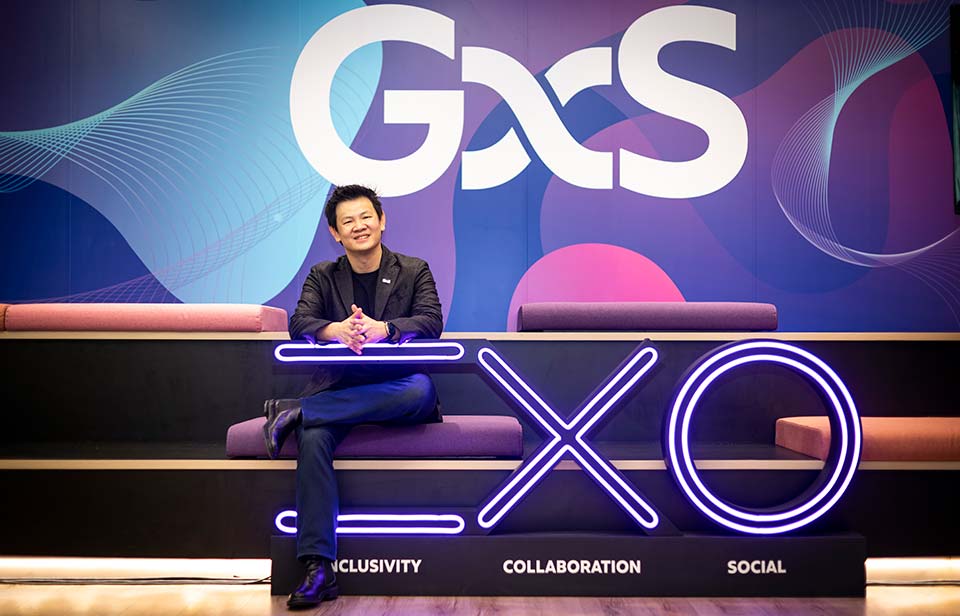The launch of two digital banks in Singapore on consecutive days offered a chance to assess the strategy of new entrants into an already crowded market. The short answer: ecosystem and brand are everything.
On August 31, GXS, the digital bank backed by southeast Asian super app Grab and incumbent telco Singtel, was the first to announce its plans (but not actually launch – that will happen on September 5). Two wholesale digital banks, Ant Group-backed Anext Bank and Greenland Group-backed Green Link Digital Bank, both commenced operations in June, serving small and medium-sized enterprises.
We are a bank born by digital natives for digital natives
Charles Wong, GXS
Held on the top floor of Grab’s funky urban headquarters in Singapore’s One-North, home to all of Singapore’s coolest businesses as well as a Lucasfilm building styled after the Star Wars Sandcrawler, GXS’s event brought an emphasis on Generation Z-branded style.
Charles Wong, the former Citibanker who is chief executive of GXS, described it as “a homegrown bank on a mission to support the needs of the entrepreneurs, gig economy workers and early-jobbers in our community”.
“We are a Gen-Z bank; we are a bank born in the digital age,” continued Wong. “We are a bank born by digital natives for digital natives.”
GXS is going all-out for that community – as it should do, since there really aren’t that many unexploited niches to target – and the event rested chiefly on a demonstration of its app.
Pockets
GXS’s chief innovation is a savings model called ‘pockets’, in which customers can customize their accounts and create separate sub-sets of their main account for specific needs, and attach their own photos to them.
This being Singapore, Wong demonstrated by taking a picture of his daughter, attaching it to a savings pocket and saying it was to save up for ‘enrichment classes’ (mere school never quite being sufficient for the ambitious parent). The account then helps motivate the saver towards reaching their goals through a series of targets and nudges.
But the presentation was light on any further detail, and Wong retreated frequently to key messages and slogans: easing the pain points for customers, redefining banking services, helping with savings dreams.
(There were a lot of dreams involved. The word appeared five times in three paragraphs in a branded note provided to attendees, titled: ‘Come dream with GXS.’)
Drawing Wong on the bigger issues – pathway or timeframe to profitability, the expectations of the bank’s dramatically different founding shareholders, movement from savings to lending or other income-generating products – was challenging. Instead, he just referred to the fact that demonstrating a profitable business model was a requirement of the Monetary Authority of Singapore granting a licence.
“As part of the MAS application we needed to submit a path to profitability, and definitely that’s something we are adhering to very closely,” Wong said.
One imagines it will take time: GXS already has 250 employees and is still hiring, Wong said, so there is already quite a cost base.
It was also never entirely clear what pain points really exist in Singapore’s heavily banked and digitally savvy environment today. Hidden fees on minimum balances were one example, and GXS made frequent reference to a statistic that “two in five adults are underbanked” in Singapore.
That’s properly sourced – it comes from a Bain & Co report in 2019, and the specific chart in that report cites Euromonitor, the World Bank and Temasek as sources – but it feels very surprising to one who lives in Singapore.
The same but different
The next day, September 1, brought the launch of Trust Bank, backed by Standard Chartered and FairPrice Group, which most Singaporeans know for its supermarket chains but is actually a collective of social enterprises related to food, and is linked to the NTUC trade union.
One should be careful about comparing the two directly. GXS is one of four newly licensed digital banks, two targeted at retail and two at SMEs, and is the first of the retail-targeted licensees to commence operations. Trust Bank comes out of a December 2020 decision by the MAS to give Standard Chartered Bank (Singapore) Limited a status called Significantly Rooted Foreign Bank, which among other things allowed it to secure an additional full bank licence to establish a subsidiary to operate a new business model, such as a digital-led bank.
In practical terms, this means, for example, that Trust Bank can have ATMs, and GXS can’t. It also means Trust Bank can open a client experience centre (it’s careful not to call it a branch) designed to help educate people who still need some help getting comfortable with digital banking.
Beyond that, while GSX spoke so much of the gig economy, Trust highlighted traction among the elderly, though it says it aims at every segment.
Nevertheless, there were similarities in approach: the streamlined app, a savings account championing no hidden fees, the promise of interest rates.
Unlike GXS, Trust launches with a credit card, the first in the market that allows customers to select their own repayment date upfront, and it also offers insurance. Another innovation is that it is the first card in the market allowing customers to switch between debit and credit cards in-app.
There was also a similar refusal to set any kind of timeframe for profitability. Chief executive Dwaipayan Sadhu said the bank will not sell StanChart products and is expected to stand on its own two feet as a viable entity, but beyond that there were few numbers.
“Trust Bank is completely independent,” Sadhu said. “We are running our own management team, our own products, and absolutely we will be looking at the business in isolation. We believe that we have a very sustainable business model.”
We do know that the shareholders in Trust invested S$400 million ($285 million) in it.
Times achanging
The two offerings are bonded by something else: the fact that they are launching into a market dramatically different to the one that existed when they applied for their licences. In early 2020, when Grab and SingTel got together to bid and StanChart was considering the possibilities of a subsidiary licence, hardly anyone had heard of a coronavirus, and a fair chunk of the population had never experienced inflation or rising rates either.
A pandemic, a war, a supply-chain crisis and a transformed rates landscape later, the two new banks have emerged blinking into the world and must be wondering if their model still works in this unrecognizable place.
Both chief executives were quick to argue, probably correctly, that the trials of the last two and a half years have only heightened trust in digital banking.
We have digitized the entire rewards experience
Dwaipayan Sadhu, Trust Bank

“The pandemic has really accelerated a lot of the digitization that was happening anyway,” said Sadhu. “Even clients who may have had some objections to [digital banking] are much more willing now to come into the fold.”
Wong said: “Whatever we have come across in terms of pain points, in the last two years they have been magnified.”
Perhaps the interest rate rises in the world over the last 12 months mean that the new offerings are going less hard on loss-leading interest rates, which had been expected at the time the licences were first announced.
Trust does offer a base interest rate of 1% on deposits above S$50,000 ($36,000) – or below that for NTUC union members – and GXS bills itself as helping “your money to work as hard as you”, with interest rates on savings account “competitive with fixed deposit accounts of banks.”
But the rates aren’t really the headlines. “There are pain points beyond interest rates,” said Wong.
What really bonds them is their ecosystems. GXS will start out by targeting those who are already customers of Grab or Singtel, which between them are already entwined with at least half the national population.
“Within the ecosystem, we serve across more than three million customers,” Wong said.
Grab, in particular, has gone to great effort to make its app essential to everyday life: at heart a ride-hailing app, it is also a widely used wallet, food-delivery service and shopping mart.
A glance at the homescreen today shows special offers for mooncakes, bubble tea, several restaurants, a night safari, credit and pay-later deals, and bus and ferry tickets to Malaysia and Indonesia, among countless other things.
The success of GXS will stand or fall upon its ability to convert people from existing platforms onto the new bank app.
Trust, in turn, is differentiated not just by the fact that StanChart is an established bank that has been in Singapore for 160 years, but the extraordinary power of the NTUC FairPrice brand and – this can’t be overstated – the LinkPoints loyalty system that is attached to it. Trust will allow people to earn LinkPoints using the card and comes with a real-time rewards tracker on the app.
“We have digitized the entire rewards experience,” Sadhu said. “If you bank with other banks, you do not really know when you are getting a reward or missing out on a reward.”
Again, if the bank can leverage its backers, there is reason for optimism. Its two founders have an ecosystem so wide that it delivers more than one million customer experiences in Singapore every day.
“One of the key differentiators for us is… the fact that we have the ability to go and tap into the NTUC and FairPrice ecosystem,” Sadhu said. “Definitely, we hope and expect that if we build real value, it will become easier to attract clients to join us at each of their interactions.”
Hard case
Will either of them really challenge banking conventions, ease pain points, make banking more pleasant?
This would be an easier case to make were it not for the fact that Singapore’s incumbent DBS, UOB and OCBC – particularly DBS – have already put considerable effort into these things for years.
DBS’s ATMs used to tell customers “it was a joy serving you,” a salutation that was mercifully axed some time ago, but the idea of reimagining banking has been in its DNA for as long as Piyush Gupta has been its chief executive.
“It’s clear that the Singapore banking market is extremely well-developed, and everybody offers digital banking services,” says Sadhu. “But when you talk to clients, or even when we use the banking products ourselves, we still find many, many gaps.”
He emphasized again the issue of transparency around rewards: “There are still tremendous opportunities for disrupting.”
Wong said: “Being well banked does not mean being well served.”
If the two new banks can market themselves successfully as differentiated offerings to the ecosystems their backers already inhabit, they have a chance.
Whether there’s room for Sea’s long-awaited digital bank too, if it ever arrives at market, is a separate question.




